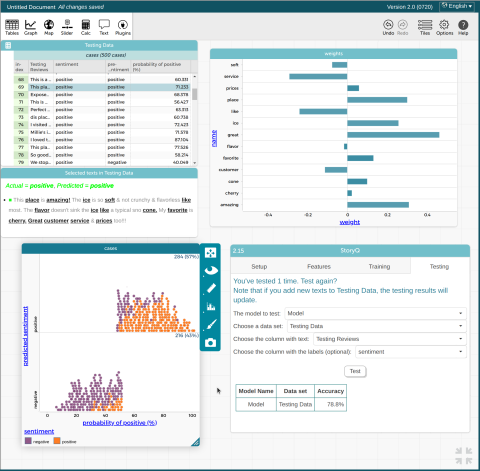Body
Image

Narrative Modeling with StoryQ - Linking AI, Language, and Science
As artificial intelligence (AI) transforms our society, it is essential for students to understand its mechanics, how machines learn from data, and the role of humans from diverse backgrounds and expertise in shaping AI. While computer science standards and organizations have emerged with commendable approaches, they often relegate experiences to self-selecting students who already show interest in the topic, and most students remain unaware of how AI is reshaping their future. Further, the AI workforce suffers from a severe lack of diversity. The StoryQ project brings innovative curricula and technology to equip students from diverse backgrounds to envision future careers in this new AI-driven workforce. By embedding AI education within a narrative context, StoryQ makes complex topics like machine learning more relatable and easier to understand. The platform encourages students to bring their own cultural and personal perspectives into their learning, allowing them to craft stories that reflect their identities while exploring AI technologies. This approach teaches technical skills while emphasizing the human aspects of AI development, including the ethical dimensions and the importance of diverse perspectives in shaping these technologies. StoryQ has been developed through a collaboration between the Concord Consortium, Carnegie Mellon University, and North Carolina State University, ensuring a robust and research-backed educational tool.
Pillar 1: Innovative Use of Technologies in Learning and Teaching
StoryQ is a web-based tool that integrates text mining with narrative modeling to teach artificial intelligence (AI) concepts. Requiring no local installation, it enables students to access and use it from any internet-connected computer. The activities blend traditional subjects such as mathematics and language arts with computing, making AI accessible and relatable.
Pillar 2: Partnerships for Career and Workforce Preparation.
This project advances STEM and ICT workforce development, emphasizing AI’s impact on future careers. By partnering with educational institutions and industry leaders, we create authentic learning environments where high school students explore AI through text mining, developing essential skills for tech-driven careers. Our collaborative efforts involve designing research-based curricula that integrate real-world AI applications, ensuring students are well-prepared for a technology-centric workforce.
Pillar 3: Strategies for Equity in STEM Education
Our project prioritizes equity in STEM by tailoring the StoryQ curriculum to meet the needs of underrepresented groups. Through partnerships with community organizations and teachers, we ensure our AI tools and content are widely accessible and engaging. Our approach includes targeted recruitment, inclusive teaching methods, and culturally relevant curricula, all designed to empower a diverse student body to explore AI-driven careers.

Discipline(s)
Computer and informational technology science
Data Science
Emerging Tech (Artificial Intelligence, Quantum Computing, and Blockchain)
Mathematical sciences
Other
Target Gradespan(s)
Middle school (6-8)
High school (9-12)
Target Participant(s)
Youth / students
Educators
Project Setting(s)
Formal Education
Informal Education
Other
Category
Developing and Testing Innovations (DTI)